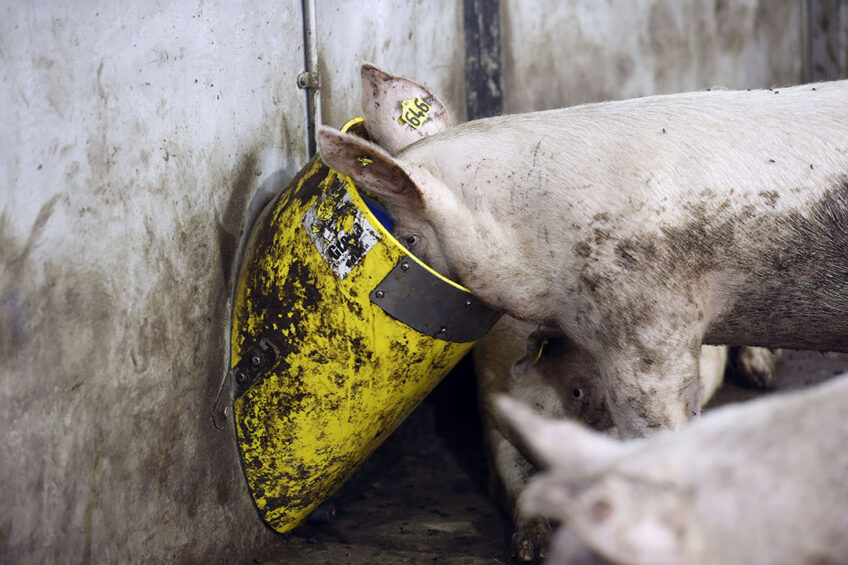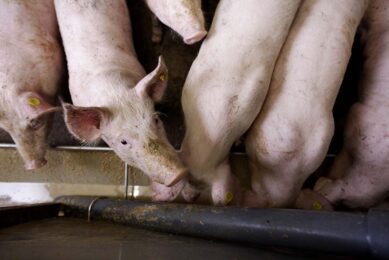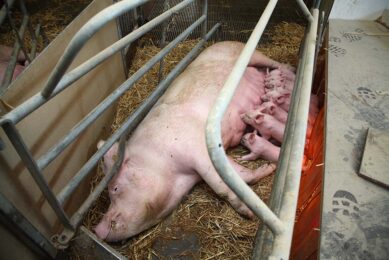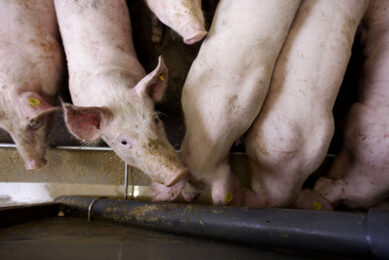Fibre-rich diets for pigs: pros and cons

Cereal grains and protein supplements usually provide the required energy and nutrients for pigs. However, considering the high demands and prices, swine producers are required to find low-cost alternative co-products to feed pigs. Most of these co-products with high energy and nutrients are fibre-rich. This has both positive and negative effects.
A fibre-rich diet has a lower nutritive value for pigs. This is due to the lack of proper digestive enzymes, which in turn results in lower performance. Therefore, typically a minimal level of fiber is included in pig diets. On the other hand, when fermented in the gut, some fibre components positively impact satiety and animal behaviour.
What is dietary fibre in nutrition for pigs?
Dietary fibre consists of carbohydrate polymers with 10 or more monomeric units, that are resistant to enzymatic hydrolysis in the digestive system. Plant carbohydrates include sugars, disaccharides, oligosaccharides, starch, and non-starch polysaccharides. Sugars, oligosaccharides, and starch constitute the interior of the plant cell. Non-starch polysaccharides are the main parts of the plant cell walls. Pigs only secrete digestive enzymes required to break down starch. They do not secrete the non-starch polysaccharides.
Impact on pig growth performance
Studies show conflicting result regarding the impact of high-fibre ingestion on pig growth performance. In growing pigs, diets containing either 7% guar gum or 7% cellulose decrease growth rate and final bodyweight. In addition, supplementing 20% distillers dried grains with soluble in nursery pig diets and 30% in growing pig diets reduces body weight. These results suggest that decline in pig growth rate is limited to the growing period rather than the finishing period. It is notable that feed intake does not always decrease when the pigs are fed high-fibre diets. Supplementing fibrous feedstuffs to pig diets dilutes dietary energy content. This in turn increases feed intake to compensate for the required energy.
Impact on nutrient digestibility
High-fibre diets negatively affect pre-cecal and total tract nutrient digestibility in pigs. Soluble fiber in diets enhances digesta viscosity, hinders diffusion of substrate and enzymes in the gut. It also obstructs nutrient digestion and absorption. Insoluble fibre decreases digesta transit time. It also allows less mixing time for digestive enzymes and dietary components. Diets that are rich in non-starch polysaccharides encapsulate nutrients and hinder their accessibility to digestive enzymes for hydrolysis. In addition, fibre-rich diets enhance thickness of the unstirred water layer adjacent to the intestinal mucosa. This impairs nutrient digestion and absorption, as well.
Impact on gut health
Gut microflora ferments dietary fiber and creates acetic, propionic, and butyric acids along with carbon dioxide, hydrogen, and methane which supply energy, and improve gut health and development in pigs. Furthermore, some components of dietary fibre promote beneficial gut bacterial proliferation, prevent colonisation of opportunist pathogens, and reduce severity of gut infections. For instance, starch fermentation increases bifidobacterial growth, pectin fermentation stimulates lactobacilli proliferation, and insoluble non-starch polysaccharides fermentation enhances cellulolytic Ruminococcus-like bacteria and xylanolytic Clostridium-like bacteria growth.
Impact on behaviour and welfare
Restricted feeding is a common practice in gestating sows to prevent excessive body weight gain. However, it does not provide enough food to achieve satiety. This results in aggression and stereotypies. Fibre-rich diets delay gastric emptying, enhance stomach content swelling and fermentation products for pregnant sows. That in turn decreases the sensation of hunger and aggression and behavioural problems associated with restricted feeding. The effect of fibre-rich diets on satiety and behaviour depends on the physicochemical properties of the dietary fibre. Soluble fibre delays nutrient absorption and decreases physical activity after feeding. In addition to this, it increases volatile fatty acid production, provides energy, prolongs the feeling of satiety. It also prevents certain stereotypies and thus is paramount to sow welfare.
Concluding remarks
Incorporating fibrous co-products in pig diets reduces the cost of swine production and thus enhances profitability. Moreover, ingestion of fibre-rich diets is associated with impaired nutrient digestibility, increased gut development and health, and improved sow behaviour and welfare. Although, the impact of fibre-rich diet on pig growth performance is contradictory. Therefore, additional research is required to find the impact of fibre source and inclusion levels on pig performance, health and welfare.
 Beheer
Beheer








 WP Admin
WP Admin  Bewerk bericht
Bewerk bericht